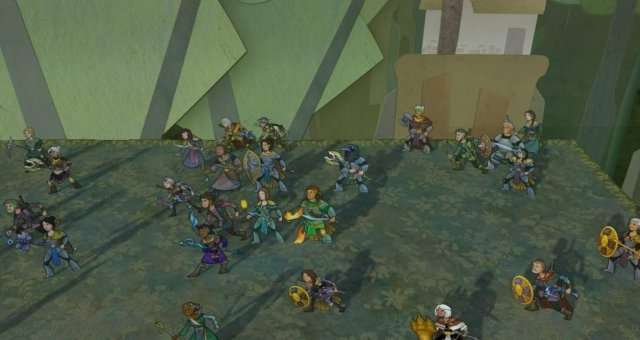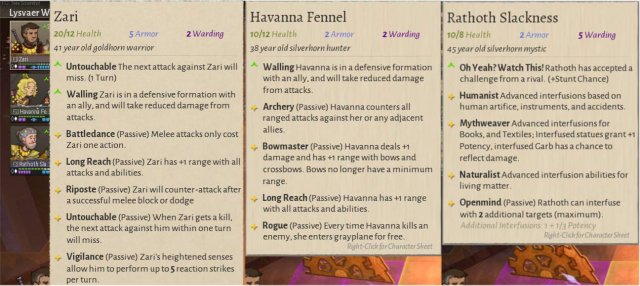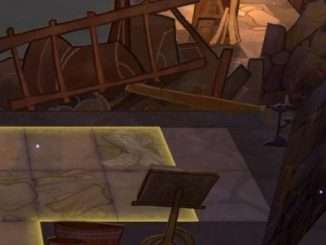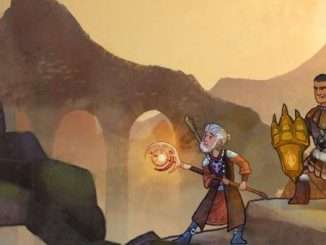
Guide to Wildermyth Character Builds – A simple classification of build types, with an overall picture of the skill structure as well as the explanation of how to optimise the synergy between abilities and heroes.
Guide to Character Build
Overview
In this guide you would find the builds that I particularly find powerful and fun to play with. The build defining abilities would be listed first and where their synergy comes from would be explained, following with the discussion about good complementary abilities and useful scenarios. The abilities that might look good in paper but don’t work well in real world would also be covered.
However, there are still a few skills not included in this guide. It’s not that they are certainly bad, it might be that they don’t generate a high synergy with other skills or with the team listed in this guide. Perhaps you would find better use of them.
The builds recommended for the 3 classes are as follows:
- Warrior builds – Guardian, Berserker.
- Hunter builds – Sniper, Melee Rogue.
- Mystic builds – Tactician, Openmindist.
This is an example of my trio in the final fight of the legacy campaign. Please note that only the passive skills (innate) or effective effects are shown.
Warrior
For a warrior to perform multiple attacks every turn, he needs «Vigilance», «Battledance» or «Riposte».
Guardian build
Vigilance, Long Reach, Battledance, Zealous Leap
«Vigilance» allows the warrior to easily perform 4 (or more) reaction strikes. The warrior reacts to any movement within his weapon range, including those moving away. Coupled with «Long Reach» and a long range weapon (spear) offers a sweeping radius of 3. This would enable the warrior to clean up 3 ~ 4 approaching threats very early in the game.
Team synergy
A sniper with «Archery» skill and/or a melee rogue with «Thornfang» skill.
- «Battledance» allows two attacks or one attack and then guard, while «Zealous Leap» lets him jump into a proper position without spending an action point. With both skills, the warrior can perform two attacks or attack & guard combos, after a leap.
- «Heroism» adds one additional action once in a combat, compared to «Battledance» & «Zealous Leap» combo, which adds one additional attack every other turn.
- «Paladin» could also do the trick, and it is done every turn. «Zealous Leap», though only usable every other turn, offers more flexibility, either ending a turn with an attack or on guard.
Enchantment
- «Fire» or «Leaf (stunt)» effect would be multiplied by the number of reaction strikes.
- «Leaf» provides a stackable damage absorbing shield. Let me call this «HP Shield». It’s a good safeguard to stack a few before entering the major confrontation.
- «Fire» can clean up those 2-HP annoying thingies without losing precious action points. You may switch from Leaf enchanted weapon to Fire enchanted weapon after you build up enough hp shield. Otherwise, consider «Broadswipe» that deals bonus damage to ALL enemies within range.
- «Stone» shredding armour is fine but it might not be necessary if you have armour ignoring hunters finishing off the rest. «Water» refunds a used action point in your turn, which is not going to work with Vigilance.
Weapon
Knock-back weapons are usually not preferred if the plan is to finish up all the enemies with a flanking rogue, but it may work wonders with Vigilance in case of retreat.
Berserker build
Vigilance, Sentinel, Battledance
«Sentinel» added to the Guardian build enables the warrior to lunge towards the enemies one after another more aggressively.
It is powerful but not without risk or cost. The risk is it may bring the warrior into reach of a group of (unseen) enemies, while the cost is the warrior may lose team synergies (walling, flanking, archery, etc.) Another drawback is that it doesn’t work well in case of retreat.
This build may require someone in the team to have the ability to rescue the warrior when things go wrong, such as Flashcone, Treecall or Aid, for example.
Useful Skills
- «Untouchable» – useful if the warrior is low on defensive skills and couldn’t get the leaf enchantment or Aid. With «Vigilance» , you should be able to skip at least one attack each turn.
- «Riposte» – will upgrade the Guardian to an Angel, demolishing all that could still move after the Guardian’s sweeping Vigilance attacks. To make it work, the warrior may have to focus more on dodge/block rather than armour.
- «Broadswipe» deals bonus damage to ALL enemies within range, which is a good secondary skill. It allows you to clean up some trash enemies without losing a precious action point.
- «Untouchable» , «Riposte» , «Broadswipe» are what I’ll consider after completing the basic Guardian build.
*Note: Some big guys are immune to counter-attacks.
Caution
- «Bloodrage» – looks great for a Berserker, but to make it work, one needs to get hurt first. To get hurt intentionally, one needs to basically lose all the armour and temporary hp (aid, leaf stunt). While there is no heal afterwards, I fear such high investment won’t pay off.
- «Engage» – you may taunt one enemy at a time and in the next turn it mostly has died already. The 1 point armour gain for a turn is negligible. If any ally is in danger, perhaps it’s easier to try to move the threat away, blind them, or hide.
- «Shieldshear» it’s not bad for the enemies with very high armour class. However, the more effective attacks would be from the grey plane, or penetrating shots. Shredding 2 armour off a single enemy every other turn is too slow.
Shooting
It’s also pretty useful to shoot with a warrior but there doesn’t seem to be an effective shooting build I could think up for a warrior. The warriors, with the focus on melee skills and melee accuracy, that use two different types of melee weapons (two enchantments), plus the throwing axes/knives off-hand, haven’t let me down though.
Hunter
For a hunter to perform multiple attacks every turn, he needs «Archery» or «Thornfang».
Sniper build
Archery, Bowmaster, Piercing Shot.
- «Archery» – Hiding next to your defensive warrior (and all allies) allows the hunter to counter all ranged attacks (unlimited) including those against adjacent allies.
- «Bowmaster» is recommended over «Long-range» for its +1 damage and its bow attack in melee range. With Bowmaster’s ability to attack adjacent enemies, the sniper would benefit more from wielding 2 bows with different enchantments, or a crossbow with an offhand as the secondary.
- «Rogue» or «Piercing Shot»: Rogue status ignores armour completely but the hunter is revealed when a shot doesn’t kill, which happens very often when countering ranged attacks. On the other hand, Piercing damage (1+ potency) is reliably useful. That said, the free invisibility is also too sweet to give up. For me the two skills are about even, and I won’t hesitate getting both.
In place of «Archery», «Ambush» is pretty good if things come as expected. On the other hand, «Archery» wins hands down when things go south. The two skills could work nicely together but taking other skills first before having both of them should result in greater synergy earlier.
Enchantment
«Fire» or «Leaf» could maximise the effect of «Archery» . «Stone» enchantment (shred) is not useful while the hunter has Rogue or Piercing shot.
* Note: In case there is a need to stay hidden, stay away from your allies so the counterattacks won’t be triggered.
Melee Rogue build
Thornfang, Rogue, Long Reach
- «Thornfang» – adds an action point after a melee kill. Since it doesn’t stack with Heroes or water enchantment (action point refund) ,and it is not compatible with Archery, Ambush, Piercing shot, or Bowmaster, it’d generate greater synergy if other abilities are also melee oriented. A melee hunter, working with a warrior nearby, using the benefits of flanking, could reliably finish most, if not all, of his unfinished jobs, one after another.
- «Rogue» – turns invisible after a kill from direct damage, making the next attack ignore armour
- «Long Reach» plus a long range weapon to increase the range to 3, saving the moving point.
Enchantment
«fire» for reducing nearby enemies’ hp and producing next possible kills. «leaf (stunt)» for HP Shield, stackable, that compensates melee hunter’s lower defence.
Weapon
Knock back is not preferred since it would break the killing streak.
* Note: A melee rogue could still use a bow. Compared to Sniper build, he loses the +1 damage bonus, armour ignoring / piercing bonus, and probably lower range accuracy.
Teamwork
«Flashcone» can hide an ally when needed. From time to time it might save your ally from being maimed. It won’t work to turn the whole team invisible in an escape event, since all enemies would start searching. However, it would have its very good use after some point.
- Note 1: Mystic can hide with «Arches» and «Naturalist». Warrior cannot hide at all.
- Note 2: «Windwalk» seems like a natural ability for Hunters, but Hunters are fast and stealthy enough already. If your team needs it, it is probably best for the Mystics.
Mystic
Mystic is probably the most iconic class in this game, where most of the strategy derives from her abilities to interfuse with the environment.
In my humble opinion, basic interfusions are good enough for everything. Elementalist build mainly improves damage. Naturalist / earthscribe build specially offers more tactic deployment, mostly outdoors. Humanist plus Mythweaver offers the only stunning effects (except certain stunt effect), mostly indoors.
Elemetalist has its use in most cases. The other two specialisations, though having limited use and lower damage, offers greater crowd control effect in the right scenario.
Interfusions that create objects
- «Arches» – creates a tree that pins adjacent enemies.
- «Ignite» – creates an interfused blaze that delivers immediate damage.
- «Earthscribe» – reproduces bones that impede enemies.
Major strength for each specialisation
«Elementalist» with «Ignite»
- Undying fire: it saves an action point with «Ignite».
- Explosion of multiple woods for greater damage burst. However, it requires two or more action points for interfusion.
«Naturalist» with «Arches»
- When summoning a tree with «Arches», the mystic enters greyplane until next (aggressive) action, which means, invisible in enemies’ turn. In a defence scenario where you have no shelters, you may summon a forest. You may even push forward into the enemies by conjuring the enemy pinning trees, since the mystic would stay invisible.
- Summon ‹an› ally out of danger, or into a better tactic position. But I fear it would need «windwalk» to make it more tactically useful. With «windwalk», the mystic can pull the allies to the other side of the enemies. Otherwise the mystic could only summon the ally backward.
«Earthscribe»
Is a bit lonely here, but this skill got my team through a very tough escape event, which otherwise I couldn’t find a better way to reliably accomplish. With one bone pile at the corner, the mystic created a line of bone wall, which was used to produce layers of walls in different directions.
«Humanist» & «Mythweaver»
- Stun: The former stuns with tools, while the latter stuns with books. They enemies cannot act and their dodge/block are weakened. A very useful effect in narrow spaces, where other effects don’t work well.
- Insidious Filament – “stacks” 2 poison points each time an enemy moves/stays next to the infused objects. The enemy may simply die in the beginning of next turn.
- Greater Constrict effect from Textile is a single action that does not end turn, allowing another attack for free.
- Not common outdoors but not rare. Some hollow trees or rocks are also statues for example.
Useful Skills
- «Openmind» – with which the mystic doesn’t need to spend an action point to withdraw old interfusions, and could prepare more interfusions for later use when he has spare action points.
- «Long Reach» – It allows the mystic to interfuse with the objects farther and attack the targets farther from the interfused objects (mainly limited to single target effect).
- «Aid (Once)» – doesn’t actually offer any hp. It conjures up an illusionary HP shield. It’s better used before injury since the injury won’t go away with Aid. If you are lucky enough, it reduces the chance of being maimed and the time needed for recover. You may use Leaf enchanted weapons instead. At old ages, the heroes almost couldn’t recover from a serious injury. «Aid» or Leaf enchantment seems quite useful when considering to send the old bones to the battlefield in the last chapter. Aid relies on potency and the Mystic usually has the highest potency.
- «Heroism (Once)» – In dire situations, it’s a game changer to be able to attack once more, even though there’s only one chance to use Heroism in a combat. While warriors/hunters have battledance/thornfang and reacion strikes, allowing them to attack multiple times. The only resort for mystics is heroism and water enchantment (stunt).
Conditional Skills
- «Windwalk» – It’s not really realistic for everyone to learn «Windwalk» so as to rush through an escape event altogether, and this method might not turn out well. However, if team scatters, or the Mystic is responsible of crowd control (Naturalist/Earthscribe), his ability to get a good position would be important. Otherwise, the mystic doesn’t really need to move fast.
- «Compulsion» – It’s nice to move «an» enemy to a desired place. However, some environmental objects would block the path and some bosses are immune to it. Similar effects could be done by quite a few other interfusions, such as Naturalist using vines. Most important of all, for the builds above, they hunger for multiple approaching enemies rather than one.
Openmindist (Generalist)
Openmind & Long Reach
- «Openmind» with «Longreach» could prepare a more flexible tactic deployment, providing flanking from all directions, immediate response for unexpected guests with available resources, or interfusion-walling bonus (may require interfusion skills). It also makes use of the wasted action points during the wait and you won’t loose an action to withdraw when things change.
- Openmindist works well with all crowd control interfusions, particularly when enemies may come from different directions or different rooms.
- Openmindist also makes a powerful Elementalist, since the two skills increases the variety, range and damage of the Elementalist.
Tactician (Specialist)
3~4 abilities among Humanist, Mythweaver, Earthscribe, Arches and Naturalist
A movement control build with stun, drag, pin, summon and poison. The questions is indoor or outdoor oriented, or both? It really depends.
Outdoor interfusions are limited in narrow spaces, while there are not many (they are not rare though) objects outdoors that could be interfused by indoor skills.
Openmind is also very helpful for a Tactician.
Team
A team of three, with a Warrior, a Hunter and a Mystic, is quite solid for most battles, if all their abilities could be properly built. However, the ability cards come randomly, the heroes age quickly, and accidents (events) may happen that take your heroes away forever. Therefore, some recruits after certain point are actually necessary. Besides, a few more hands will speed up the construction.
Warrior
The life span of warriors is usually 3 or 4 chapters long. Warriors trained in chapter 1 or 2 will either retire or too old in Chapter 4 or 5. Since warriors level up pretty quick, it’s safe to train a second warrior in Chapter 3.
Mystic
Mystics level up slowly. Even though they have a good chance to go through all 5 chapters, their physical condition is not that good. At old ages, it would take them half a year to a whole year to recover from a serious injury. It might be a good idea to train a second mystic no later than chapter 2 or 3.
Hunter
Hunters could stay for 4 chapters or 5. Similarly, it won’t be bad to have a second hunter in chapter 2 or 3.
Split
When you start to have more than 5 heroes, try splitting them into 2 teams, say 3/3, 4/3, 4/4 etc. It seems the tougher fights usually take place in the beginning and in the end of in each chapter. The fights in between the major combats are not that difficult. Find a balance to prepare the dream team for the final fight.





Be the first to comment